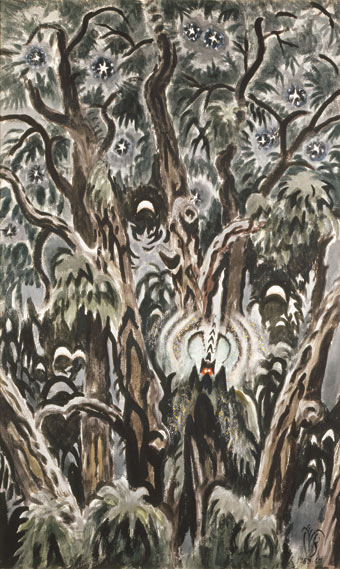Charles Burchfield's Night Skies at the Burchfield Penney Art Center
by Jack Foran



Oh My Heavens
Charles Burchfield’s graphite sketch drawings of the night sky preliminary to watercolor full paintings reveal the artist as scientist. But more artist than scientist. The paintings are remarkably true to the scientific data, to a point. Ultimately, the art, the painting, rules.
The drawings are reminiscent of the night sky paintings of his predecessor scientist/artist Galileo Galilei. On Burchfield’s sketch of stars in the constellation Orion from around 1917, he notes the observation hour of “5 AM (4 AM Standard Time)” and that his depiction is from memory—probably later the same day—but neglects to record what day. An astronomy student commentator writes that “since Burchfield noted the time, we know that this sketch was made mid to late August. Orion is toward the east during this period and becomes visible after not being seen during the mid-summer months.” In addition to the stars, Burchfield notes on the sketch, lower left, the imminent approach of “Dawn.” The commentator—now as art critic—points out that “with the newly returned Orion and the dawning sun, this sketch contains two possible symbols of rebirth and renewed hope.”
The night sky drawings and related watercolors—some originals, some reduced-size but serviceable reproductions of works from galleries around the globe—are currently on show at the Burchfield-Penney Art Center. The exhibit is entitled Oh My Heavens.
Also on view, from 1916, is a study of the moon haloed with brushy concentric circles, light and dark. An explanatory note says that the haloes are an optical illusion due to refraction of moonlight through atmospheric ice crystals. The haloes are whitish where the light is bent once, shading to reds and blues where bent more than once.
How all this works out in a completed painting is demonstrated in the 1917 large-scale watercolor, Orion and the Moon, showing the constellation, the moon, and the first light of dawn brightening the lower left area of the picture.
Burchfield gets back to the Orion subject matter some forty years later, in 1962, in the painting Orion in Winter, now in a gallery in Spain.
In his own handwritten brief expository on this work, the artist says:
…the greatest problem [with the picture] was designing the sky. While Sirius, Orion the Pleiades and the moon were in the same part of the sky, they were too far apart to be used realistically. What was needed was a redesigning for the purpose of the picture, not an actual sky map; but they had to appear reasonably true.
This was worked out completely before the actual painting was begun…Great license was exercised…the great nebula of Orion was enormously enlarged, and placed outside the limits of the constellation, on both sides. This to give the feeling that the whole universe is in motion.
The painting was completed in two days, but later four inches was added to the top of the sky to make it more dominant.
You can’t see the addition in the Orion in Winter reproduction, but can see just such an addition in the nearby original Heat Lightning watercolor, about which Burchfield wrote in a note to himself while the work was in progress: “A major miscalculation was the main thunderhead which turned out to be not high enough. To raise it to the height it ought to be will crowd the ‘Big Dipper’ and ‘Cassiopeia’s Chair’ too much, as well as the North Star, so I think I will have to add to the picture at the top.” A strip of about four inches.
The painting shows high banks of clouds against a dark moonlit sky above and shadowy landscape below, of woody terrain pockmarked with numerous oxbow lakes. The terrain was based on Burchfield’s observations from an airplane from a 1961 trip New York City to Buffalo. So New York State. “It occurred to me suddenly that this was exactly the sort of landscape I wanted for my Heat Lightning picture,” he wrote.
Seldom does an art exhibit demonstrate so precisely just how an artist worked. Or some of the ways he worked. The exhibit was put together by Tullis Johnson and Alana Ryder of the Burchfield Penney, and Kevin Williams of the Whitworth Ferguson Planetarium at Buffalo State. It continues through July 28.
blog comments powered by Disqus|
Issue Navigation> Issue Index > v12n29 (Week of Thursday, July 18) > Art Scene > Charles Burchfield's Night Skies at the Burchfield Penney Art Center This Week's Issue • Artvoice Daily • Artvoice TV • Events Calendar • Classifieds |









 Current Issue
Current Issue